I was working at my desk in mid-June when I got a call from my friend Virgil Vosse, who owns North Archery, from France. He said that he was one of four Parisian artisans who were being interviewed for a documentary to be aired on France’s largest television station. The kicker was he had finagled the company to include me in the interview for my work with Traditional Bowhunter® Magazine, which had influenced Virgil to become a bowyer. They had agreed to fly him over to the States, as long as we could do the interview at my ranch here in Idaho. I had been asking him to come over and hunt elk with me for several years, so I told him of course we could do that.
The next day I received an email from Julie Benzoni, the journalist, who wanted to verify if this series of events would be alright, and when she and her cameraman should arrive. After a back and forth series of emails, she replied that they would fly Virgil to Boise on August 28th, and then she and her cameraman (woman, as it eventually turned out) would fly in on September 10th for three days to conduct and film the interview. It sounded like fun, but it took me several weeks to work out the logistics on my end.
I had my truck packed by the time Virgil arrived in Boise late in the afternoon on the 28th, so we enjoyed a nice dinner at my ranch that evening while going over plans. Mid-morning the next day we swung by Cabela’s to do some last-minute gear shopping, then pointed the truck north, up along the picturesque Payette River canyon into Long Valley, eventually stopping to refuel before heading up into the mountains to my elk camp. My daughter, Kerri, and her husband, Jon, were going to join us later that evening for the hunt.
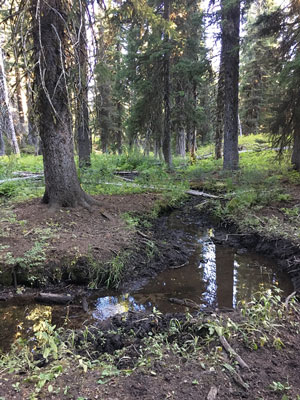
This rill holds a series of wallows in the only flat glade in the Bowl.
After camp was set up, I pulled out a topo map and gave Virgil the layout of where we were and filled him in on all I knew after three decades of hunting this mountain. A quick walk around camp, checking game trails, showed plenty of elk tracks, but very little deer sign. Hopefully, I thought, I would find an opportunity to put Virgil into a position for either, as we both had deer and elk tags.
Kerri and Jon showed up just before dark and pitched their teepee while I prepared dinner. The last of my moose steaks were the main course, along with baked potatoes and sweet onions, which I stuffed with butter and double wrapped with aluminum foil and slowly simmered in hot coals. A bottle of wine…no, two…were opened and we sat under the stars while we ate and discussed our plans for the morning.
Up well before first light, our plans were that Virgil and I would hunt down the mountain toward several wallows I knew of. Over the last thirty years or so, I have taken almost two dozen elk on this mountain, and several were taken near these wallows. With the heat of the fall weather, and the excellent snow pack we had the last winter, I expected the seeps to be flowing and the wallows being hit. Kerri and Jon decided to hunt a different section of the mountain for the day.
The morning air was cool as we drank coffee and put together sandwiches, fruit, and energy bars for lunch. The stillness was palpable; there was no wind, and no auto or airplane noise as I drank my coffee and felt the wildness start to envelop my senses. I love this place, and after more than three and a half decades, I always feel alive whenever I leave camp wondering if—or when—the opportunity to put a stalk on game will happen today…maybe tomorrow. For the moment, it was just comfortable to listen to the silence. With about 20 minutes until pink light, we hoisted packs, mounted headlamps, and took off to our predetermined areas to hunt for the day. Opening day of archery season has always been special to me. It is inevitable that the day will arrive when I will be unable to do these hunts anymore, so every morning that I wake up and look around my part of this mountain is a blessing. And so it was today, sharing with friends and family once more.
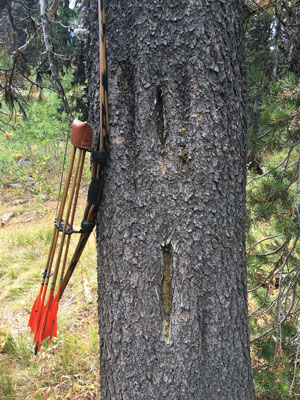
Blaze marks on this pine tree mark the old abandoned sheep and cattle trail from the valley below to the lush meadows of the mountain.
The trail from camp is steep, falling off the knob where camp lies and into an open meadow. Across the meadow is a steeper drop off that leads to the Bowl where dozens of seeps and rills harbor mushrooms, huckleberries, and other succulents the cervids, bear, and grouse feed on each fall. Many years ago, it was named “Falling Dirt Trail” by my friend Nick Nydegger and the name stuck…for good reason. The trail changes annually thanks to cattle that are grazed here during the summers, as well as deer and elk, and the massive bark beetle kill that drops huge subalpine fir and ponderosa pine trees. It takes a handhold in many places to get down, and to get back up. It is a rough challenge to conquer when game is down; however, it is the fastest, and shortest, way to get to the wallows that were our destination this morning.
We dropped down the trail and, as expected, we had to find a new route. Half a dozen trees, some more than two-foot in diameter, had changed the path that both cattle and game were using. I thought about how, so many years ago before we had such a problem with the bark beetle, I could rely on the same trails every year, with very minor changes. Time marches on, and change happens, but I still have a hard time coming to terms with the loss of so much of the forest.
At the bottom of the trail, we crossed a narrow ravine with a seep gurgling down the mountain. Tag alder, mountain ash, and chokecherry, the latter with red berries that elk and bear love to graze on, filled the ravine as it wound down the mountain toward the valley below. I half expected a grouse to flush, as I have shot dozens in this very spot; however, all was quiet today.
The trail meanders down a finger ridge, then crosses another small stream before falling into a lush melt pond that has several wallows in its tall grasses. As we slowly oozed down the trail, we stopped every few steps to glass and look around. At every turn, every opening, I expected to see or blow out game; however, all was eerily quiet, not something I am used to here in the Bowl. We stopped at a flowing stream to fill our water bottles and sit and listen for a few minutes before continuing down the hill.
As we entered the melt pond, in which all the water was long gone and the grass almost two feet high, we slipped over to one of the wallows only to find almost dry mud with old elk, deer, and bear tracks in the near-hard soil. Up above us a raven called out, then another, as they circled around us trying, as it seemed, to alert the forest that something was amiss. It’s quite a dichotomy between the noise of urban humanity and immersing yourself into the quiet magnificence of nature.

The weather this year was warm and beautiful on the mountain.
Leaving the melt pond, I ran across a scattering of bones beside the trail about 75 yards above the wallows. I knew this place, as I had killed a spike elk here back in 2010 (see “One of Those Years,” TBM, Jun/Jul 2012). I called Virgil over to look at the elk bones, explaining how that year went (I was fortunate to take a mule deer, antelope, and this elk all within a two week stretch). As I did with my daughter the year before, I was once again reliving my many years, and hunts, in this place with Virgil. Here and there, as we slowly hunted down the mountain from camp, every turn in the trail had a story to tell, and I would stop and relate it to him. Just beside us I pointed out a blaze mark on one of the few old pine trees that marked the cattle and sheep trail that herders and ranchers used decades ago to move their herds up into the forest in the spring, and back down in the fall. I was hoping I wasn’t boring him, but since we had not seen or heard an animal, I figured it was the right thing to share my experiences here.
We had been still-hunting for almost an hour when we made the final stream crossings below the wallows. The thermals were still going downhill, so we slowly oozed up the rise until we crested the finger ridge to expose the meadow and wallows. All was quiet as we topped the rise to look and listen.
That is when all hell broke loose.
It sounded like we had jumped a herd of cattle. Then I saw several cow elk run out of a stand of tag alder to my left, then they ran back to the right. They kept running back and forth in front of us less than 40 yards away as if spooked, but the wind was in our favor and we hadn’t made any noise. A cow and calf ran out in front of us about 30 yards away when a bull made a bugle farther up the draw.
“Virgil! Move up to that fallen log and I’ll try and bring him in!” I whispered, desperate to get set up quickly, as every elk hunter knows things happen fast when you are this close to them. It was obvious the elk were not spooked by us, but rather were being herded around by a bull; a cow was definitely in heat somewhere back up in the brush and seeps.
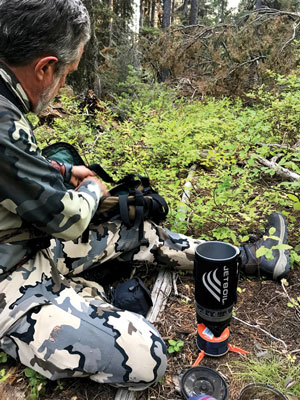
Virgil knelt behind the fallen tree and nocked an arrow while I moved back behind a pine and licked a reed into my mouth. I gave a weak bugle, angling the call behind me, when all of a sudden a young bull charged straight out of the alders and stopped not 15 yards in front of Vigil, head on. From behind the pine, I could see the bull’s left side: a solid 4-point. Trying not to get caught in the open, I turned my head backward and gave a soft cow call. The bull roared right into Virgil’s face while staring at the tree I was hiding behind. I gave another cow call and the bull, not seeing what he thought he should, started angling off to our left; he was going to go around to try and get the wind in his favor.
Virgil was perfectly still as the bull started to trot across in front of him. Just before the bull went behind a screen of small firs, I cow called. He stopped and turned to look at me as Virgil drew and released. He couldn’t have been 15-16 yards from Virgil.
At the shot I heard a tick, then the bull jumped and started across the meadow between two large wallows. I cow called twice, very quickly, and he stopped just out of my sight. Virgil stood up and started back toward me. I was afraid he had hit a twig and missed, as I heard his arrow hit something on the way. I shrugged and lifted both hands. He nonchalantly gave me a thumb’s up with a stoic face that caught me off guard.
“Good shot?” I whispered as he walked up to me. He looked like nothing happened, and then he started to shake.
“I think so,” he whispered back. “Let’s go set down and wait a while.”
We backed up about 15 yards over the rise to a flat spot and removed our packs. I pulled out my Jet Boil and started to heat water for coffee. “You hungry?” I asked.
His hands were shaking…I knew he had a good arrow and just now he was visibly excited. “No…I want to find him! Did you see him?”
I relayed that yes, I heard him stop when I had cow called and that I heard a thump shortly after that right where he would have been.
It was a quiet 20 minutes until we decided to go and take a look at where I last saw him. Walking over to where the bull was standing when he shot, there was nothing: no blood, no hair, no arrow, and no scuff marks. Slowly, we slipped down to where we could look across the grass and trees surrounding the wallows when Virgil turned to me and excitedly yelled, “Is that him?”
I slipped up, an arrow nocked, and there, exactly where I last heard the bull, he lay dead, not thirty yards from where he was shot. A beautiful 4×4 bull, the arrow had taken out both lungs quartering away. I looked at my watch: it was 8:40 a.m. opening day.

The bull only went about thirty yards. Not bad for opening day!
Handshakes and hugs followed, and then we snapped several photos. The thrill of such an event suddenly wanes when you come to terms that the real work is just about to begin. Besides the fact that it was going to get very warm, we were also a mile from camp down a very steep and fall-down-choked mountain. The good news was we had all day to get it back up to camp and hung on the shaded meat pole that has been used for over three decades.
We arrived in camp with what we could carry out with our hunting packs: backstraps, tenderloins, ribs, and neck meat. Kerri and Jon were already back in camp, so after some water and a bite to eat, all of us grabbed pack frames and game bags and headed back down to get the rest. By mid-afternoon, we had the elk boned out in several bags and hanging in camp. Exhausted, tired, sweaty, and bloody, it was time for showers all around before a feast of sautéed elk tenderloin, fried potatoes and onions, and a fresh garden salad. It had been another memorable opening day on the mountain.
As for the rest of the hunt, and the ensuing three days with Virgil being interviewed and filmed…and receiving a beautiful bow Virgil made for me from woods he procured from my home town, Wahiawa, Hawaii…well, that is another story for another day. Today was Virgil’s day, another opening day on my little piece of the mountain.
**********
Equipment Note: On this hunt, T.J. used a custom 56# Black Widow takedown longbow, cedar arrows tipped with Zwickey No Mercy heads, and Great Northern quiver. Virgil used a 51# North Archery Taïga recurve of his own design, footed wood shafts, and 145-grain Eclipse broadheads.
- When the game goes down, the knives and hard work just begins.
- There is nothing quite like fresh elk steaks in camp.
- It only gets steeper after here.
- Kerri and Jon helping bone out the quarters making an easier pack out from deep in the Bowl.





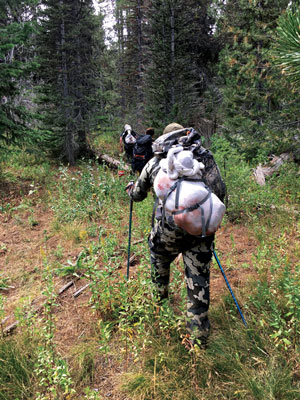
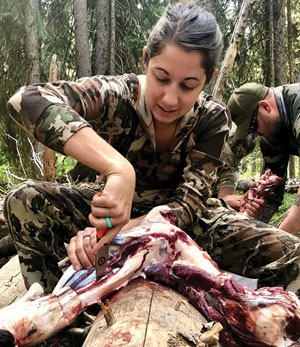


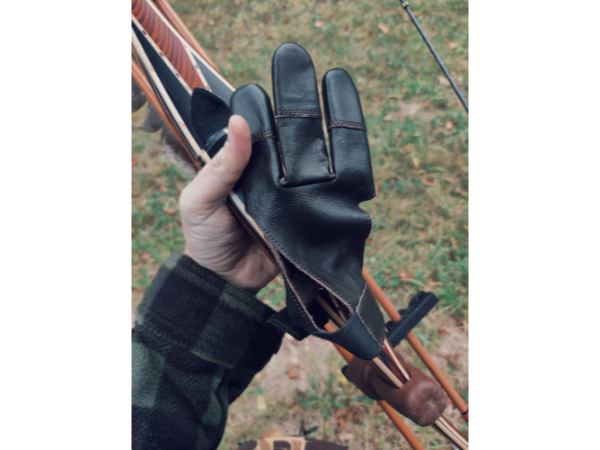

Leave A Comment